AP Full Official:Associate of Science in Computer Information Systems
Campus: National Campus
Completed by: Business Division
AP Review Submission Date: March 28th, 2014
AR Review Cycle: Fall 2011 – Fall 2013
Program Mission
Associate of Science in Computer Information Systems provides students with a solid foundation in theory and practice of the computer information systems and prepare them to meet the immediate job market needs, adapt themselves to the rapidly evolving computer industry and further their education in a higher degree program. This contributes to the college’s mission of assisting in the development of the Federated States of Micronesia, and to be globally connected.
Program Goals
- Demonstrate an in-depth understanding of technical concepts and ethical issues pertaining to information systems
- Demonstrate theoretical knowledge and practical skills in the management and strategic use of information systems and technology.
- Demonstrate proficiency in the use of different software applications significant to manipulating and analyzing information as well as generating and presenting reports in the various functional areas of business.
- Demonstrate solid foundation skills in database design and management, web engineering, programming, and networking;
- Demonstrate the ability to adapt to latest technologies using their foundation knowledge and skills from CIS.
Program History
In today’s world, information is a very vital resource in an organization. In order to efficiently utilize information of any form in an organization however, this has to be processed within the organization. This is where information technology with its varied tools becomes very indispensable.
In the Federated States of Micronesia, however humble its beginning might be, it is imperative that this information technology, coupled with communications has to be taught and learned in the lone college so that the people can be educated and organizations can adapt to, and gradually become at pace with the world trend. With this necessity, the semester of Fall 1998 saw the emergence of a new academic program offering at COM-FSM’s Business Division, the Associate of Science Degree in Computer Information Systems.
Program Descriptions
The Associate of Science in Computer Information Systems program concentrates on organizational applications of information and communications technology and the development of systems and their management. Students receive a fundamental understanding of programming, web engineering, database designing and networking, which prepare them for high-in-demand careers such as programmers, webmasters, network administrators, systems analysts, etc.
Program Admission Requirements
Applicants must meet the following admission requirements to be matriculated into this degree program:
- Have graduated or will graduate from high school at the end of the current school year, or have a GED certificate;
- Have a minimum high school grade point average of 2.0 as measured on a 4.0 scale, or a minimal score of 35 on each section and an average of 45 for all five sections of the GED test, and;
- Be accepted by the COM-FSM Admissions Board.
Program Certificate/Degree Requirements
Degree Requirements Summary
- Satisfactory completion of the applicable General Education Core - 29 credits
- Satisfactory completion of the prescribed CIS major courses - 42 credits
TOTAL 71 credits
- Cumulative Grade Point Average (GPA) of at least 2.0
Degree Requirements in Detail
Preparatory Courses – By Placement
General Education Core courses
English (9 credits)
EN 110 Advanced Reading (3)
EN 120a Expository Writing I (3)
EN 120b Expository Writing II (3)
Mathematics (3 credits)
Any 100 level or above mathematics course (3)
Natural Sciences (7 credits)
A science course with Laboratory or AG 110 or AG 140 (4)
A non-lab science or AG 101 (3)
Social Sciences (3 credits)
SS 150 History of Micronesia (3)
Computer Applications (3 credits)
CA 100 Computer Literacy (3)
Exercise Sports Science (1 credit)
Humanities (3 credits)
Any course in art, music, history, literature, philosophy,
or language (3)
|
CIS Major Courses
Information Systems (20 credits)
IS 201 Computer Information Systems (3)
IS 220 Computer Programming w/lab(4)
IS 230 Database Design (3)
IS 240 Webpage Design (3)
IS 260 Business Information Systems (3)
IS 280 Introduction to Networking-w/lab (4)
Business (7 credits)
AC 131 Accounting I (4)
BU 101 Introduction to Business (3)
Communications (3 credits)
EN/BU 121 Business Communication (3)
Mathematics (6 credits)
MS 101 Algebra and Trigonometry (3)
MS 150 Statistics (3)
Electives: Any two of the following courses (6 credits)
CA105 Data Analysis Using Spreadsheets (3)
IS245 Desktop Publishing (3)
IS 270 Geographic Information Systems (3)
|
Program Courses and Enrollment
Spring 2014 |
| Course |
No. of Sections |
Course Enrollment |
Section Fill Rate |
Redundancy |
| |
|
Fall 2011-Fall 2013 |
|
|
| IS 201 Computer Info. Systems |
2 |
277 |
92.33% |
no |
| IS 220 Computer Programming |
2 |
164 |
99.39% |
no |
| IS 230 Database Design |
1 |
148 |
98.67% |
no |
| IS 240 Web page Design |
1 |
150 |
100% |
no |
| IS 245 Desktop Publishing |
1 |
81 |
108% |
no |
| IS 260 Business Info. Systems |
1 |
117 |
78.00% |
no |
| IS 280 Intro to Networking |
2 |
123 |
102.50% |
no |
| CA 105 Data Analysis |
1 |
161 |
107.33% |
no |
Program Faculty
JOSEPH FELIX, JR, Associate Professor
Bachelor of Science in Computer Science
(Park College, Missouri)
Master of Science in Information Systems
(National University, California)
|
MARLENE MANGONON, Associate Professor
Bachelor in Computer Data Processing Management
(Polytechnic University of the Philippines, Philippines)
Master in Business Administration
(Virgen Milagrosa University, Philippines
|
EDPER CASTRO, Assistant Professor
Bachelor of Science in Information and Computer Science
(Cebu Institute of Technology, Philippines)
Diploma in Computer Science
(Open University, University of the Philippines, Philippines)
Masters in Information Systems
(Open University, University of the Philippines, Philippines)
|
George Mangonon, Assistant Professor
Bachelor of Science in Mathematics
(University of the Philippines, Philippines)
Master in Business Administration
(Virgen Milagrosa University, Philippines),
Doctorate in Business Administration (sans Dissertation)
(Virgen Milagrosa University, Philippines),
IT Background: Programming - COBOL and Visual Basic (Systems Technology Institute, Philippines and Informatics, Philippines)
|
Faculty to Student Ratio-CIS Program 2011-2013
| Year |
Spring |
Spring Raio |
Fall |
Fall Ratio |
| 2011 |
172 |
1:57 |
198 |
1:66 |
| 2012 |
177 |
1:59 |
211 |
1:52 |
| 2013 |
173 |
1:43 |
160 |
1:40 |
Program Indicators
| Assessment of course student learning outcomes of program courses |
IS201-Computer Information Systems
Success Rate for SLO
| Course Learning Outcome |
| |
SLO#1 |
SLO#2 |
SLO#3 |
SLO#4 |
SLO#5 |
SLO#6 |
SLO#7 |
Number of Students |
| Spring 2011 |
55% |
73% |
82% |
66% |
23% |
41% |
59% |
44 |
| Fall 2011 |
80% |
82% |
84% |
73% |
75% |
66% |
77% |
44 |
| Spring 2012 |
24% |
71% |
63% |
53% |
100% |
71% |
54% |
24 |
| Fall 2012 |
60% |
60% |
60% |
72% |
66% |
72% |
83% |
47 |
| Spring 2013 |
50% |
52% |
42% |
81% |
69% |
46% |
58% |
48 |
| Fall 2013 |
54% |
93% |
89% |
61% |
79% |
61% |
86% |
28 |
| Average |
54% |
72% |
70% |
69% |
69% |
60% |
70% |
39 |
CA105-Data Analysis
Success Rate for SLO
| Course Learning Outcome |
| |
SLO#1 |
SLO#2 |
SLO#3 |
NO. STUDENTS |
| Spring 2011 |
81% |
93% |
93% |
27 |
| Fall 2011 |
89% |
81% |
78% |
27 |
| Spring 2012 |
88% |
85% |
96% |
26 |
| Fall 2012 |
89% |
86% |
61% |
28 |
| Spring 2013 |
75% |
63% |
63% |
24 |
| Fall 2013 |
85% |
96% |
96% |
26 |
| Average |
85% |
84% |
81% |
26 |
IS220-Computer Programming
Success Rate for SLO
| Course Learning Outcome |
| |
SLO#1 |
SLO#2 |
NO. STUDENTS |
| Spring 2011 |
70% |
96% |
23 |
| Fall 2011 |
65% |
96% |
27 |
| Spring 2012 |
84% |
100% |
19 |
| Fall 2012 |
60% |
96% |
25 |
| Spring 2013 |
82% |
82% |
33 |
| Fall 2013 |
82% |
82% |
33 |
| Average |
74% |
92% |
26 |
IS240-Webpage Design
Success Rate for SLO
| Course Learning Outcome |
| |
SLO#1 |
SLO#2 |
SLO#3 |
SLO#4 |
SLO#5 |
NO. of STUDENTS |
| Spring 2011 |
77% |
77% |
62% |
62% |
65% |
26 |
| Fall 2011 |
52% |
52% |
64% |
64% |
72% |
25 |
| Spring 2012 |
28% |
94% |
89% |
83% |
89% |
18 |
| Fall 2012 |
70% |
100% |
78% |
78% |
65% |
23 |
| Spring 2013 |
69% |
100% |
81% |
88% |
81% |
16 |
| Fall 2013 |
39% |
100% |
100% |
67% |
83% |
18 |
| Average |
56% |
87% |
79% |
74% |
76% |
21 |
IS230-Database Design
Success Rate for SLO
| Course Learning Outcome |
| |
SLO#1 |
SLO#2 |
SLO#3 |
SLO#4 |
SLO#5 |
SLO#6 |
SLO#7 |
NO. of STUDENTS |
| Spring 2011 |
80% |
80% |
80% |
80% |
80% |
76 |
76% |
25 |
| Fall 2011 |
57% |
57% |
57% |
87% |
87% |
78 |
78% |
23 |
| Spring 2012 |
72% |
72% |
72% |
64% |
64% |
76 |
76% |
25 |
| Fall 2012 |
92% |
92% |
92% |
57% |
57% |
64 |
64% |
25 |
| Spring 2013 |
71% |
71% |
79% |
83% |
71% |
71 |
62% |
24 |
| Fall 2013 |
100% |
100% |
70% |
83% |
87% |
91 |
87% |
23 |
| Average |
79% |
79% |
75% |
76% |
74% |
76 |
74% |
24 |
IS245-Desktop Publishing
Success Rate for SLO
| Course Learning Outcome |
| |
SLO#1 |
SLO#2 |
SLO#3 |
SLO#4 |
SLO#5 |
NO. of STUDENTS |
| Spring 2012 |
85% |
85% |
85% |
89% |
89% |
25 |
| Fall 2012 |
93% |
93% |
93% |
74% |
74% |
27 |
| Spring 2013 |
93% |
93% |
93% |
52% |
52% |
27 |
| Average |
90% |
90% |
90% |
72% |
72% |
27 |
IS260-Business Information Systems
Success Rate for SLO
| Course Learning Outcome |
| |
SLO#1 |
SLO#2 |
SLO#3 |
SLO#4 |
NO. of STUDENTS |
| Spring 2011 |
74% |
74% |
74% |
96% |
23 |
| Fall 2011 |
64% |
64% |
100% |
86% |
14 |
| Spring 2012 |
42% |
42% |
84% |
84% |
19 |
| Fall 2012 |
58% |
58% |
89% |
89% |
19 |
| Spring 2013 |
67% |
67% |
73% |
73% |
15 |
| Fall 2013 |
71% |
90% |
67% |
71% |
21 |
| Average |
63% |
66% |
81% |
83% |
19 |
IS280-Introduction to Networking
Success Rate for SLO
| Course Learning Outcome |
| |
SLO#1 |
SLO#2 |
SLO#3 |
SLO#4 |
SLO#5 |
SLO#6 |
NO. of STUDENTS |
| Spring 2011 |
95% |
95% |
95% |
76% |
76% |
81% |
21 |
| Fall 2011 |
65% |
65% |
65% |
90% |
90% |
80% |
20 |
| Spring 2012 |
100% |
100% |
100% |
100% |
100% |
100% |
20 |
| Fall 2012 |
95% |
95% |
100% |
89% |
89% |
89% |
19 |
| Spring 2013 |
95% |
95% |
95% |
70% |
70% |
70% |
20 |
| Fall 2013 |
90% |
95% |
95% |
80% |
75% |
90% |
20 |
| Average |
90% |
91% |
92% |
84% |
83% |
85% |
20 |
|
| Assessment of program student learning outcomes |
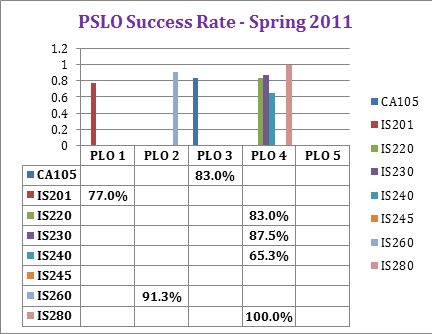
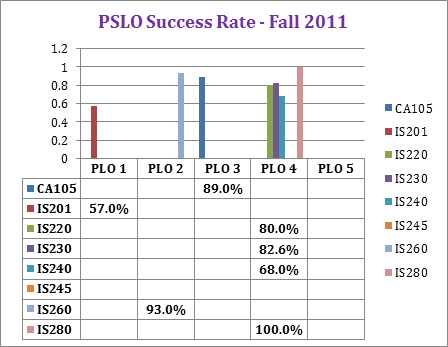
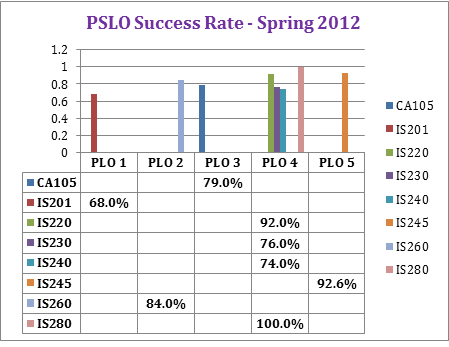
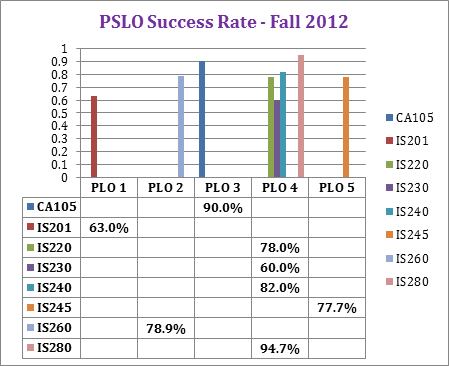
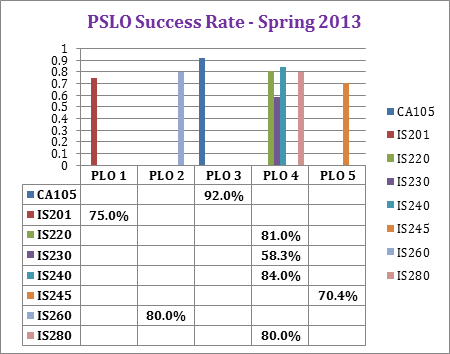
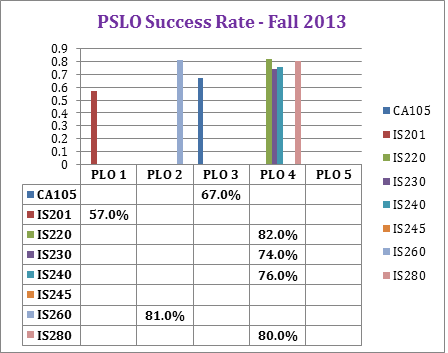 |
| Program enrollment (historical enrollment patterns, student credits by major) |
| CIS Program Enrollment 2011-2013 |
| Year |
Spring |
Fall |
| 2011 |
172 |
198 |
| 2012 |
177 |
211 |
| 2013 |
173 |
160 |
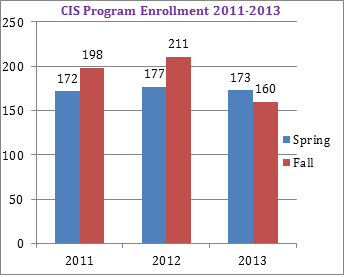
All Program Enrollment 2011-2013
| Year |
CIS |
Bus Admin |
HTM |
Marine Science |
HCOP |
LA |
Micro Studies |
Teacher Prep |
Others |
| 2011 |
172 |
190 |
55 |
52 |
89 |
287 |
121 |
385 |
48 |
| 2012 |
177 |
232 |
65 |
52 |
100 |
316 |
118 |
451 |
93 |
| 2013 |
173 |
186 |
65 |
46 |
123 |
249 |
104 |
404 |
98 |
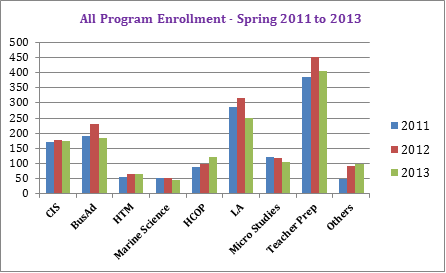
| CIS Enrollment Credits By Major for 2011-2013 |
| Year |
Spring |
Fall |
| 2011 |
2163 |
2337 |
| 2012 |
2168 |
2479 |
| 2013 |
2103 |
1987 |
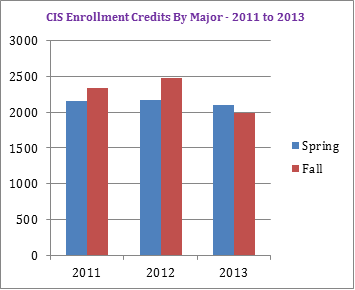
| All Program Enrollment Credits By Major for Spring 2011-2013 |
| Year |
CIS |
Bus Admin |
HTM |
Marine Science |
HCOP |
LA |
Micro Studies |
Teacher Prep |
Others |
| 2011 |
2163 |
2403 |
689 |
656 |
1219 |
3645 |
1567 |
4800 |
599 |
| 2012 |
2168 |
2756 |
817 |
663 |
1325 |
3746 |
1522 |
5379 |
1122 |
| 2013 |
2103 |
2298 |
749 |
586 |
1577 |
2801 |
1202 |
4747 |
1120 |
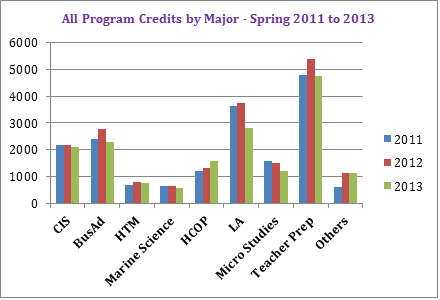
| All Program Enrollment Credits By Major for Fall 2011-2013 |
| Year |
CIS |
Bus Admin |
HTM |
Marine Science |
HCOP |
LA |
Micro Studies |
Teacher Prep |
Others |
| 2011 |
2337 |
3375 |
819 |
709 |
1526 |
4664 |
1784 |
6004 |
1224.5 |
| 2012 |
2479 |
2803 |
844 |
847 |
1813 |
3788 |
1497 |
5268 |
1398 |
| 2013 |
1987 |
2644 |
656 |
657 |
1733 |
3090 |
1312 |
4299 |
1502 |
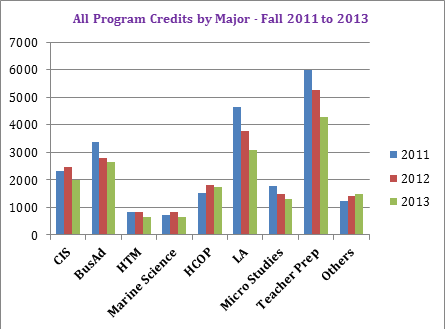
|
| Average class size |
| Year |
Spring |
Fall |
| 2011 |
21.83 |
21.00 |
| 2012 |
21.93 |
21.77 |
| 2013 |
20.85 |
18.92 |
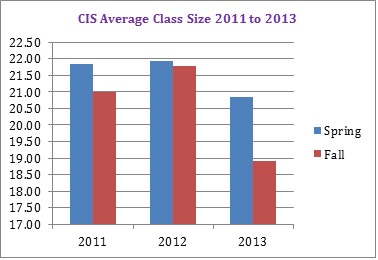
All Program Average Class Size Spring 2011 to 2013
| Year |
CIS |
Bus Admin |
HTM |
Marine Science |
HCOP |
LA |
Micro Studies |
Teacher Prep |
Others |
| 2011 |
21.83 |
21.80 |
16.67 |
14.25 |
17.00 |
22.20 |
21.36 |
16.95 |
16.37 |
| 2012 |
21.92 |
20.13 |
13.70 |
13.29 |
18.80 |
21.50 |
21.69 |
17.44 |
14.24 |
| 2013 |
20.85 |
18.59 |
11.25 |
11.43 |
15.05 |
17.62 |
21.13 |
16.90 |
14.77 |
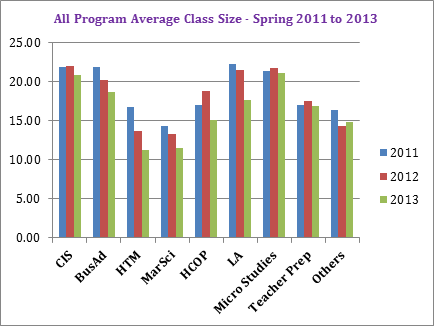
| All Program Average Class Size Fall 2011 to 2013 |
| Year |
CIS |
Bus Admin |
HTM |
Marine Science |
HCOP |
LA |
Micro Studies |
Teacher Prep |
Others |
| 2011 |
21.00 |
22.19 |
13.40 |
13.60 |
20.35 |
22.96 |
22.88 |
15.74 |
17.14 |
| 2012 |
21.77 |
21.35 |
13.00 |
10.80 |
17.91 |
20.30 |
23.79 |
14.06 |
11.19 |
| 2013 |
18.92 |
20.47 |
9.38 |
9.80 |
15.39 |
18.46 |
20.41 |
15.42 |
14.45 |
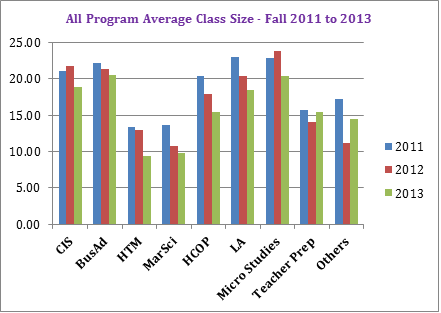
|
| Course completion rate |
| CIS Completion Rate By Major (ABC or P%) from 2011 to 2013 |
| Year |
Spring |
Fall |
| 2011 |
63.7% |
68.6% |
| 2012 |
70.4% |
71.9% |
| 2013 |
58.6% |
69.0% |
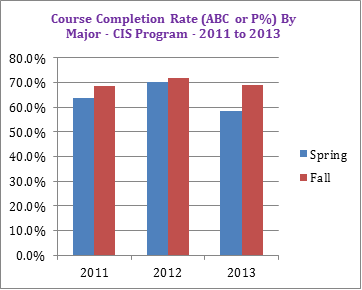
| All Programs Course Completion Rate (ABC or P%) By Major Spring 2011 to 2013 |
| Year |
CIS |
Bus.Adm. |
HTM |
Mar.Sc. |
HCOP |
LA |
Mic.Studies |
Teach.Prep |
Others |
| 2011 |
63.7% |
69.9% |
72.4% |
56.0% |
66.0% |
66.0% |
66.7% |
69.0% |
67.1% |
| 2012 |
70.4% |
65.4% |
67.4% |
67.1% |
66.6% |
61.1% |
60.3% |
67.3% |
66.5% |
| 2013 |
58.6% |
59.5% |
58.9% |
46.3% |
60.4% |
58.7% |
64.9% |
65.5% |
63.1% |
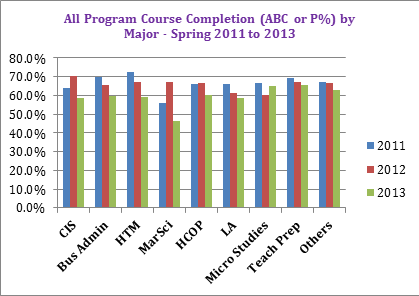
| All Programs Course Completion Rate (ABC or P%) By Major Fall 2011 to 2013 |
| Year |
CIS |
Bus.Adm. |
HTM |
Mar.Sc. |
HCOP |
LA |
Mic.Studies |
Teach.Prep |
Others |
| 2011 |
68.6% |
64.4% |
70.8% |
57.2% |
70.2% |
64.1% |
65.9% |
67.9% |
68.9% |
| 2012 |
71.9% |
65.0% |
79.8% |
62.4% |
70.3% |
62.8% |
62.5% |
70.9% |
65.4% |
| 2013 |
69.0% |
70.7% |
66.3% |
62.3% |
62.8% |
62.2% |
75.2% |
71.8% |
68.5% |
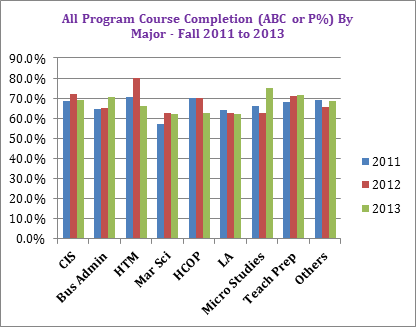
| CIS Completion Rate By Program (ABC or P%) from 2011 to 2013 |
| Year |
Spring |
Fall |
| 2011 |
73.0% |
75.3% |
| 2012 |
79.0% |
74.5% |
| 2013 |
62.5% |
71.8% |
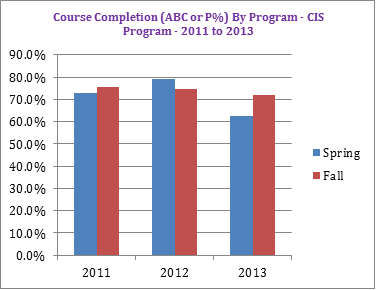
| All Programs Course Completion Rate (ABC or P%) By Program Spring 2011 to 2013 |
| Year |
CIS |
Bus.Adm. |
HTM |
Mar.Sc. |
HCOP |
LA |
Mic.Studies |
Teach.Prep |
Others |
| 2011 |
73.0% |
71.9% |
74.7% |
51.9% |
57.9% |
67.9% |
79.0% |
82.3% |
75.0% |
| 2012 |
79.0% |
70.4% |
77.6% |
57.0% |
54.9% |
67.0% |
72.0% |
74.7% |
76.3% |
| 2013 |
62.5% |
59.7% |
72.7% |
46.9% |
45.4% |
61.2% |
71.5% |
70.6% |
76.9% |
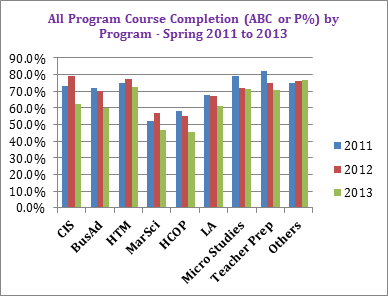
| All Programs Course Completion Rate (ABC or P%) By Program Fall 2011 to 2013 |
| Year |
CIS |
Bus.Adm. |
HTM |
Mar.Sc. |
HCOP |
LA |
Mic.Studies |
Teach.Prep |
Others |
| 2011 |
75.3% |
68.2% |
70.8% |
48.1% |
64.9% |
66.7% |
74.3% |
76.6% |
86.0% |
| 2012 |
74.5% |
58.3% |
79.8% |
41.2% |
60.5% |
65.9% |
74.5% |
71.4% |
81.0% |
| 2013 |
71.8% |
77.5% |
66.3% |
43.1% |
51.9% |
68.0% |
77.5% |
71.6% |
84.0% |
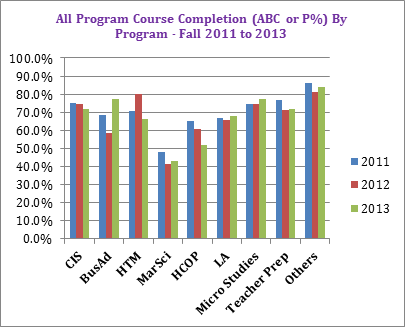
|
| Student persistence rate (semester to semester) |
| Cohort |
Rate |
| 2012 |
84.6% |
| 2013 |
86.0% |
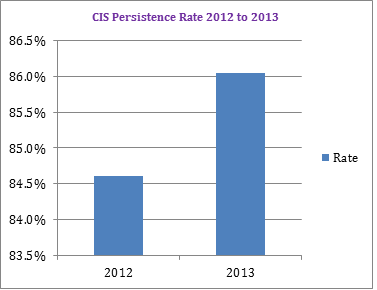
| All Program Persistence Rate from 2012 to 2013 |
| Cohort |
CIS |
Bus.Adm. |
HTM |
Mar.Sc. |
HCOP |
LA |
Mic.Studies |
Teach.Prep |
Others |
| 2012 |
84.6% |
81.9% |
81.3% |
80.0% |
91.7% |
82.% |
72.4% |
88.7% |
66.7% |
| 2013 |
86.0% |
87.5% |
66.7% |
46.7% |
92.1% |
79% |
108.3% |
79.0% |
62.5% |
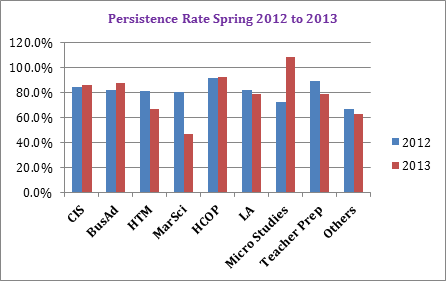
|
| Student retention rate (Fall-to-Fall for two-year programs; Fall-to-Spring for one-year programs) |
| CIS Program Retention Rate from 2012 to 2013 |
| Cohort |
Rate |
| 2012 |
84.6% |
| 2013 |
86.0% |
| All Program Retention Rate from 2012 to 2013 |
| Cohort |
CIS |
Bus.Adm. |
HTM |
Mar.Sc. |
HCOP |
LA |
Mic.Studies |
Teach.Prep |
Others |
| 2012 |
65.4% |
55.6% |
50.0% |
70.0% |
83.3% |
47.9% |
48.3% |
58% |
44% |
| 2013 |
55.8% |
75.0% |
55.6% |
40.0% |
92.1% |
51.6% |
100% |
63.% |
60% |
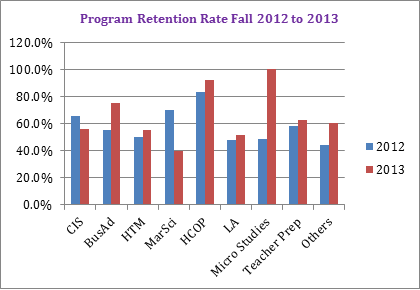
|
| Success rates on licensing or certification exams (CTE, TP, Nursing, etc) |
NONE |
| Graduation rate based on yearly number |
| CIS Graduation Rate from Fall 2008 to Fall 2010 |
| Full Term Year |
Rate 100% |
Rate 150% |
Rate 200% |
| Fall 2008 FTr |
9.8% |
22.0% |
36.6% |
| Fall 2009 FTr |
0.0% |
14.8% |
44.4% |
| Fall 2010 FTr |
4.8% |
14.3% |
|
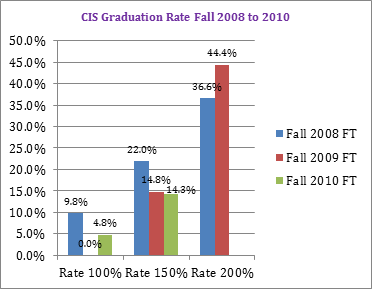
| All Program Graduation Rate from Fall 2008 to Fall 2010 - Graduation Rate 100% |
| Full term Year |
CIS |
Bus.Adm. |
HTM |
Mar.Sc. |
HCOP |
LA |
Mic.Studies |
Teach.Prep |
Others |
| Fall 2008 FT |
9.8% |
0.0% |
0.0% |
3.8% |
10.3% |
0.0% |
5.0% |
0.0% |
0.0% |
| Fall 2009 FT |
0.0% |
3.3% |
16.7% |
0.0% |
0.0% |
2.8% |
15.8% |
0.0% |
0.0% |
| Fall 2010 FT |
4.8% |
2.5% |
0.0% |
0.0% |
0.0% |
1.3% |
11.5% |
0.0% |
0.0% |
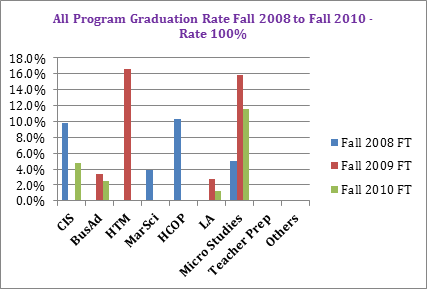
| All Program Graduation Rate from Fall 2008 to Fall 2010 - Graduation Rate 150% |
| Full term Year |
CIS |
Bus.Adm. |
HTM |
Mar.Sc. |
HCOP |
LA |
Mic.Studies |
Teach.Prep |
Others |
| Fall 2008 FT |
22.0% |
25.0% |
16.7% |
19.2% |
34.5% |
41.7% |
40.0% |
7.1% |
0.0% |
| Fall 2009 FT |
14.8% |
26.7% |
66.7% |
20.0% |
23.8% |
27.8% |
47.4% |
46.2% |
11.1% |
| Fall 2010 FT |
14.3% |
10.0% |
8.3% |
7.7% |
11.1% |
14.3% |
23.1% |
15.5% |
0.0% |
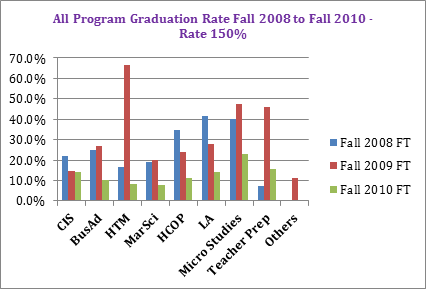
| All Program Graduation Rate from Fall 2008 to Fall 2010 - Graduation Rate 200% |
| Full term Year |
CIS |
Bus.Adm. |
HTM |
Mar.Sc. |
HCOP |
LA |
Mic.Studies |
Teach.Prep |
Others |
| Fall 2008 FT |
36.6% |
36.1% |
50.0% |
23.1% |
51.7% |
100.% |
50.0% |
35.7% |
0.0% |
| Fall 2009 FT |
44.4% |
33.3% |
133.3% |
20.0% |
38.1% |
41.7% |
73.7% |
69.2% |
22.2% |
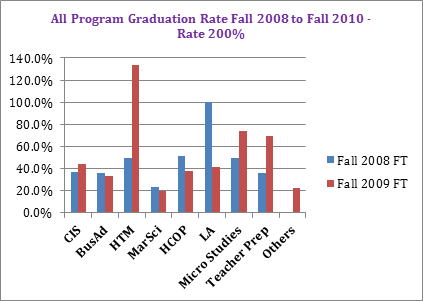
|
| Students seat cost |
Not Available |
| Cost of duplicate or redundant courses, programs or services |
No redundant courses therefore zero cost. |
| Students’ satisfaction rate |
Not Available |
| Alumni data |
Not Available |
| Employment data and employer feedback (employer survey) |
Not Available |
| Program added or cancelled at nearby regional institutions (PCC, GCC, Hawaii schools, UOG, CMI, NMC) |
Not Applicable |
| Transfer rate |
Not Available |
Analysis
Findings:
- Assessments of CSLO
| Course |
Findings |
| IS201 |
Low success rate of SLO#1 is due to transition from High-School classes to College-level classes because as the classes progresses or more particularly from SLO#2 and up success rate are relatively compared to SLO#1. |
| IS220 |
- The Thinking Skills (creative thinking, decision making, problem solving) of some students were not demonstrated well in SLO 1.6-1.9 and SLO 2.1-2.6.
- Students have difficulty in constructing mathematical expressions, relational expressions and Boolean expressions in presenting solution to a problem.
- Most of the students who passed the course only obtained a C and D grade
|
| IS23 |
Students have difficulty in constructing queries (SQL - Structured Query Language) as a demonstration of proficiency for SLO#4 using mathematical expressions, relational expressions and Boolean expressions. |
| IS240 |
- Students who do not complete the required exercises and projects fail
- Low success rate of SLO#1 resulted from not attending the first day/week of classes
|
| IS245 |
Course has a lot of hands-on activities and therefore activities are hands-on intensive in the form of hands-on exercises and capstone projects. Thus students who do not complete the required exercises and projects fails. |
| IS260 |
- Students who fail in IS220 or who have not taken IS220 or have low grades in IS220 normally encounter difficulties in fulfilling programming-related activities for SLO#4
- Concept in ERP (Enterprise Resource Planning) are hard to relate to students given there is no manufacturing company here in FSM that student could relate to and most of all such topics are discussed on 3rd year level courses for other programs like in Business.
|
| IS280 |
In SLO #5 requires basic mathematical skills that includes analysis and quantitative reasoning for doing IP Addressing and most of students were doing poorly in this SLO. |
| CA105 |
Students are doing very well in hands-on activities while they are doing poorly on the concepts and theories. The grading practice is that percentages in grading both concepts/theories and hands-on are both 50%. |
- Assessments of PSLO
- The success rate of all PSLO is overall good except for PSLO#1 interestingly on all Fall Semesters from 2011 to 2013 which has an average success rate of 59% whereas during Spring Semesters again from 2011 to 2013 it has an average success rate of 73.33%.
- Most of the CIS program courses are concentrated on PSLO#4 which is lent more on IT (Information Technology) courses rather than on PSLO #1, #2 and #3 which lend more on IS (Information Systems) type of courses.
- The whole AY 2011 PSLO#5 is not assessed not until starting Fall 2012 when IS245 (Desktop Publishing) is offered.
- Program enrollment (historical enrollment patterns, student credits by major)
- Out of 12 programs offered in National Campus CIS Program ranks 4th consistently in program enrollment and credits by Major.
- Average class size
- On all semesters from AY 2011-2013 CIS program consistently ranks either as 1st or 2nd in terms of Average Class size.
- Course completion rate
- Course Completion Rate by Program is very good which range in terms of ranking in comparison to other programs from 1st to 5th. However, Course Completion Rate by Major is not doing as good with two 8th places ranking, namely, on Spring 2011 and Spring 2013.
- Retention Rate
- Retention Rate from Fall 2011 to 2012 is in 3rd place with 65.4% however from Fall 2012 to Fall 2013 retention goes down to 55.8% which is good for 6th place among 12 programs at National Campus
- Graduation Rate
- Overall Graduation rate is good except for Full Term 2009 at 150% Rate which is 0% and is good for 8th place among 12 programs. So, 100% Rate is very good at 2nd place for Full Term 2008 and 2010 while 200% Rate is middle of the pack at either 4th or 5th place.
Recommendations:
- Convert CIS (Computer Information Systems) to IT (Information Technology) Program
- As stated on the findings above most of the CIS program courses are concentrated on PSLO#4 which is lean more on IT (Information Technology) courses rather than on PSLO #1, #2 and #3 which lean more on IS (Information Systems) type of courses. So, in that regard CIS Program should be converted to IT (Information Technology) program to focus more our resources to our inherent strength.
- To triangulate this findings the Business Division will conduct survey on different businesses here in FSM or Pohnpei as to what specific IT or IS related skills that they need from our students.
- Business Division should then start on crafting of the courses offered on the proposed IT Program including electives that would be beneficial to students here in FSM and as well as the business community. The proposed IT Program could start at the earliest on Fall 2017 or Spring 2018.
- Business Division also would start a proposal to look for bigger laboratory classrooms that would cater for IT-related laboratory classes like CISCO Networking, Server Management, Desktop Support etc.
- Bigger Laboratory room for IS280 (Networking class)
- Right now Networking class for laboratory has to be divided into two sections whereas the lecture counterpart of Networking class is only one section. This would mean that the college would have to pay extra load per semester for the faculty teaching the aforementioned class. However, if there is a big room enough to accommodate the twenty (20) students per semester then that would mean savings in terms of salary for the college.
- Smaller rooms for supposedly a laboratory and a Networking class at that is not conducive for learning. When doing hands-on activity for example student has to do it one-at-a-time in front of his/her classmates because of space limitation. Doing cabling/wiring for Networking connection is pretty limited also because the student could not easily move tables to do networking across the room which is more suitable supposedly for such activity.
- Real networking equipment for student to test and play around with
- Students are only limited playing with hubs which are virtually obsolete technology in this era of networking. A more suitable one would be manageable switches and also routers. Also a networking server should be there also for students to test and play with. This server could also be use to teach additional classes in the future like Windows Server technologies and Linux-based NOS (Network Operating Systems). This would enhance in achieving SLO#6 and SLO#3.
- And regarding the space limitation mentioned earlier although a bigger room would be suit of having switches and routers but there is a work around with this one, namely, when routers, switches and servers could be mounted on the wall instead of taking spaces standing vertically (which would mean occupying more space for the limited room).
-
Recommendation for CSLO Assessment Findings for each IS courses
| Course |
Recommendations |
| IS201 |
The instructor will pay extra attention to each student for the first 4 weeks so as to gear them up to college-level thinking from high-school level thinking in terms of doing their assignments and exercises. Activities also will be crafted in such a way that it will not be more grade driven but rather it would be more value driven. For example each student will be given the same exact points in their research and subsequent reporting regardless if the reports are good or bad. However, those reports that are excellent will be given extra points that would be carried on to their succeeding exercises on the next phase of the class. |
| IS220 |
- Add MS100 as pre-requisites with a grade of B
- Breakdown the scope of SLOs. Modify course outline
|
| IS230 |
Add MS 100 with a grade of 'C' or higher as pre-requisite |
| IS240 |
- Give early warning to those who habitually failed to complete exercises
- Announcement of First Day of Instruction must be included in the college website news feed and emphasize that it is not only an orientation day but start of lecture and attendance is required and counted. Adding of classes must be done during their free time and not be used as excuse for missing classes
|
| IS245 |
Give early warning to those who habitually failed to complete exercises |
| IS260 |
Strict implementation of pre-requisite of the course |
| IS280 |
Add MS 100 as pre-requisite |
| CA105 |
Increase percentage grading on the concepts and theories to 60% and decrease percentage grading on hands-on to 40%. This will not improve their grades overall but improve their learning on the concepts and theories |
- CIS Alumni Tracker
- Create a survey form use to gather information for every graduating students this semester (Spring 2014) that could be used to track them later on.
- Coordinate with IRPO and IT on how could we make an Information System (online or not) to track alumni for CIS Program (and other programs under Business Division for that matter).
- CIS Graduates Tracker
- Generate List for all graduating students under CIS Program at every start of the semester for close monitoring.
- Pay special attention to Graduating students that are on their 3rd year (150% Graduation Rate) which is the weakness of CIS Program in terms of Graduation Rate. Also pay attention students who are in their 4th year (200% Graduation Rate) to improve ranking middle-of-the-pack ranking of CIS Program.
- Strengthen MOU Agreement with UOG and UH
- Coordinate with UOG and UG counterparts to make sure that CIS courses could be transferred to their respective institution otherwise find out in what way some courses in CIS could be automatically be transferrable to their respective institution.
- This could also mean changing our baseline courses (e.g. IS220, IS230) to match their courses.
- Monitor Retention Rate
- Get a yearly update of Retention Rate from IRPO instead of getting it at every cycle of Program Review.

























